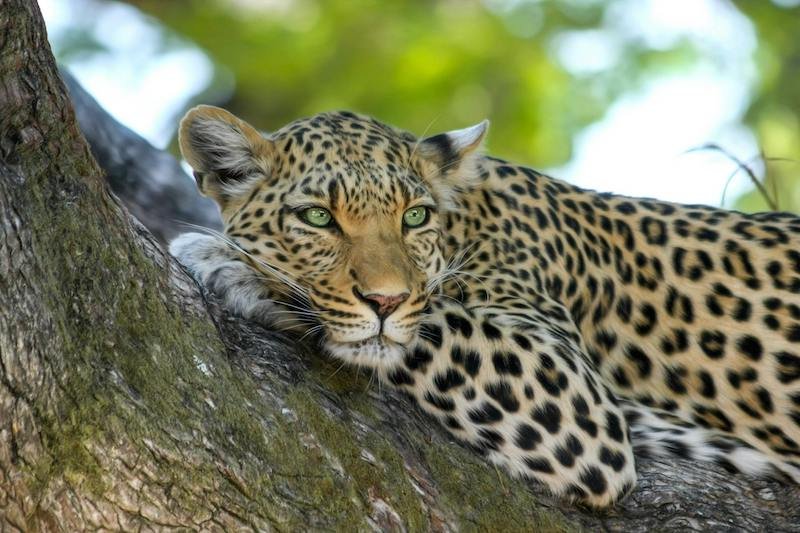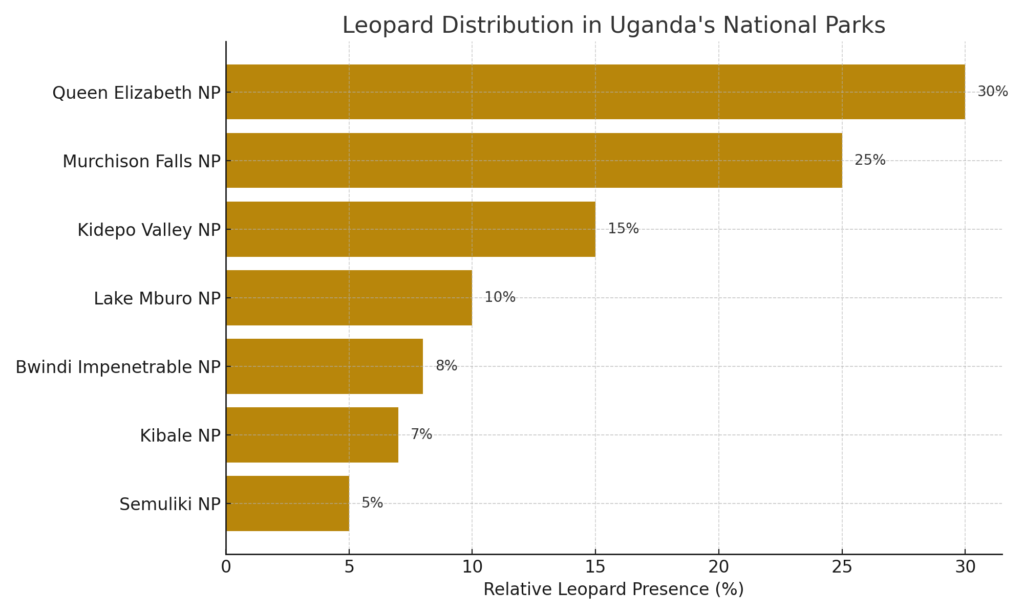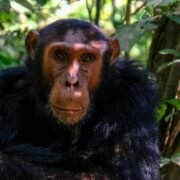
Leopards in Uganda National Parks: Habitat, Behavior & Survival

Leopards in Uganda National Parks
Leopards in Uganda are among the most elusive and fascinating predators found in the country’s national parks. These solitary, stealthy big cats captivate visitors with their beauty and power. As one of Africa’s iconic Big Five, leopards play a vital role in Uganda’s ecosystems and draw nature enthusiasts from around the world. You can spot these majestic animals in several national parks, each offering unique chances to observe them in their natural habitats. Request Your Free Quote Now
Types and Physical Characteristics
Uganda is home to the African leopard (Panthera pardus pardus), a subspecies known for its adaptability and striking rosette-patterned coat. Adult males typically weigh between 50 to 90 kg, while females are smaller at 30 to 60 kg. In addition, leopards have powerful limbs, keen eyesight, and retractable claws, making them excellent climbers and hunters.
Their spotted coats not only provide camouflage in the bush but also distinguish individual leopards. This helps researchers monitor populations in various regions.
Where to Spot Leopards in Uganda
Leopards are present in most Ugandan national parks, though sightings can be rare due to their secretive nature. Top destinations include:
- Queen Elizabeth National Park – Especially in the Mweya Peninsula and Kasenyi Plains.
- Murchison Falls National Park – Often seen on early morning or night drives.
- Kidepo Valley National Park – Remote and rugged, ideal for wildlife photographers.
- Lake Mburo National Park – Dense woodland provides ideal leopard territory.
These parks offer the dense vegetation, tree cover, and prey availability that leopards need. Their solitary lifestyle and nocturnal habits often make nighttime game drives more fruitful for leopard sightings.

(Internal Link: Explore Murchison Falls National Park)
Behavior and Social Habits
Leopards are solitary and territorial. A male’s territory may overlap with several females, but interactions are limited outside of mating. They are mostly nocturnal and spend their days resting in trees or dense vegetation.
Interestingly, leopards are known for dragging their prey into trees to protect it from scavengers like hyenas. Their climbing skill is unmatched among big cats, and they use this ability for both safety and hunting advantage.
In addition, leopards communicate through scent markings, vocalizations (such as rasping coughs), and body language. Request Your Free Quote Now
Feeding and Hunting
Leopards are opportunistic carnivores. Their diet includes antelopes, monkeys, warthogs, rodents, and birds. They are stealth hunters, relying on patience and ambush rather than speed. Their powerful jaws and strong neck muscles allow them to carry prey much heavier than themselves.
Females often hunt more frequently to provide for their cubs. They also teach young leopards how to stalk and kill small prey before they venture out independently.
Breeding and Gestation
Leopards have no fixed breeding season in Uganda. However, mating can occur year-round. After a gestation period of about 90 to 105 days, a female gives birth to 1–3 cubs. Cubs remain hidden for the first 6 to 8 weeks to protect them from predators.
Mother leopards are extremely protective and nurturing. Cubs stay with their mothers for up to 2 years as they learn the skills necessary for survival in the wild.
Life Expectancy and Population
In the wild, leopards live up to 12–17 years. In protected environments like Uganda’s national parks, their lifespan can be slightly longer due to fewer threats from humans and poachers.
While exact population numbers are hard to determine due to their elusive nature, leopards are considered vulnerable by the IUCN. Uganda’s conservation parks play a crucial role in preserving leopard populations.
(External Link: IUCN Red List: Panthera pardus)
Conservation of Leopards in Uganda
Uganda Wildlife Authority (UWA) implements conservation strategies including anti-poaching patrols, habitat protection, and ecological monitoring. In addition, community conservation programs educate locals on the importance of wildlife, reducing human-wildlife conflict.
Tourism also supports conservation. Park entry fees contribute directly to conservation programs and benefit surrounding communities, incentivizing protection of wildlife habitats. Request Your Free Quote Now
What to Do if a Leopard Charges
Leopard attacks are extremely rare, but safety guidelines are crucial:
Leopard attacks are extremely rare, but safety guidelines are crucial:
- Stay calm and do not run. Running may trigger a chase instinct.
- Make yourself appear larger. Raise your arms and back away slowly.
- Avoid direct eye contact. This can be perceived as a threat.
- Always stay inside safari vehicles unless with an armed guide.
Leopards usually avoid humans and will only act aggressively if cornered or protecting cubs.
Why See Leopards in Uganda?
Leopard sightings are a special treat in Uganda, often requiring patience and sharp eyes. Unlike other safari destinations, Uganda offers diverse ecosystems and fewer tourist crowds, making for a more authentic and peaceful experience.
In addition to leopards, Uganda offers chances to spot other big cats, elephants, hippos, and gorillas in one trip. Hence, this rich biodiversity makes Uganda an ideal destination for wildlife enthusiasts.
(Internal Link: See Uganda Safari Packages)
Conclusion
Leopards in Uganda national parks are fascinating creatures that reflect both power and mystery. From their expert hunting techniques to their role in balancing the ecosystem, leopards are a must-see for anyone interested in African wildlife. With growing conservation efforts and responsible tourism, Uganda remains a top destination for spotting these stealthy big cats in the wild.
Start planning your leopard safari today and experience one of nature’s most elusive predators firsthand. Request Your Free Quote Now
Related article: Internal Link(African Lion in Uganda National Parks)
Recent Posts
Hartebeest vs Topi in Uganda: Species, Parks & Key Differences
Mountain Gorillas and Chimpanzees in Uganda
Monkeys in Uganda: Species, Parks & Safari Guide
Tags

Thailand




